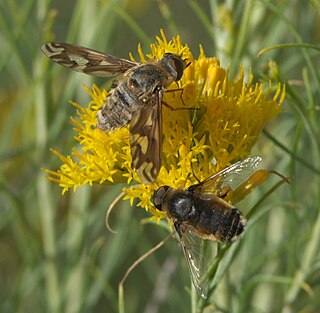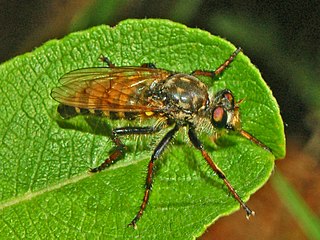
Poecilanthrax willistoni, Williston's bee fly or sand dune bee fly, is a member of the Bombyliidae insect family. This family includes the bee flies, true flies that have developed Batesian mimicry characteristics to avoid predators. That is, they look like bees because that helps them avoid bee-wary predators, but they lack stingers.

Cyrtopogon is a genus of robber flies in the family Asilidae. There are at least 120 described species in Cyrtopogon.
Cyrtopogon laphriformis is a species of robber flies in the family Asilidae.
Cyrtopogon evidens is a species of robber flies in the family Asilidae.
Cyrtopogon dasyllis is a species of robber flies in the family Asilidae.
Cyrtopogon auripilosus is a species of robber flies in the family Asilidae.
Cyrtopogon sudator is a species of robber flies in the family Asilidae.
Cyrtopogon falto is a species of robber flies in the family Asilidae.
Cyrtopogon montanus is a species of robber flies in the family Asilidae.
Cyrtopogon auratus is a species of robber flies in the family Asilidae.
Cyrtopogon inversus is a species of robber flies in the family Asilidae.

Neolasioptera willistoni is a species of gall midge in the family Cecidomyiidae.
Proctacanthella willistoni is a species of robber flies in the family Asilidae.
Cyrtopogon marginalis is a species of robber flies, also called assassin flies, in the family Asilidae.
Megaphorus willistoni is a species of robber flies in the family Asilidae.
Cyrtopogon jemezi is a species of robber flies in the family Asilidae.
Cyrtopogon plausor is a species of robber flies in the family Asilidae.
Cyrtopogon banksi is a species of robber flies in the family Asilidae.



